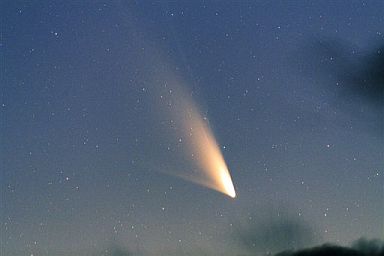Comet to come into view next week

This March 2, 2013 photo made available by spaceweather.com shows the comet, Pan-STARRS, seen from Queenstown, New Zealand. The recently discovered comet is closer than it’s ever been to Earth, and stargazers in the Northern Hemisphere finally get to see it. AP
MANILA, Philippines—Stargazers may be able to view with their naked eyes a bright comet in the western horizon at sunset early next week, the astronomy section of the state weather bureau said.
The comet known as Pan STARRS, or C/2011 L4, is expected to be visible in the Philippines, shining particularly brightly on March 10, according to the astronomical diary of the Philippine Atmospheric, Geophysical and Astronomical Services Administration (Pagasa).
“It may reach magnitude zero or brighter as it passes through perihelion within the orbit of Mercury on March 10,” Pagasa said. Perihelion refers to the point in the orbit of the comet where it is nearest the sun.
“It will be a fine binocular object and may become a bright comet that may be seen by the naked eyes,” Pagasa administrator Nathaniel Servando said.
The comet will appear like a stationary star with a tail and will be seen on a relatively low point in the horizon, Pagasa Space Sciences and Astronomy Section chief Dario Dela Cruz said.
Article continues after this advertisementThe comet Pan-STARRS was discovered by the Panoramic Survey Telescope & Rapid Response System atop the Haleakala volcano in Hawaii in June 2011, according to the United States’ National Aeronautics and Space Administration (Nasa).
Article continues after this advertisementIn early March, “the comet will pass about 100 million miles (about 161 million kilometers) from Earth as it briefly dips inside the orbit of Mercury,” Nasa said.
“Most experts expect it to become a naked-eye object about as bright as the stars of the Big Dipper,” the US agency said on its website.
“Because of its small distance from the sun, Pan-STARRS should be very active, producing a lot of dust and therefore a nice dust tail,” Nasa quoted Matthew Knight of the Lowell Observatory as saying.
“However, it could still be difficult to see. From our point of view on Earth, the comet will be very close to the sun. This means that it is only observable in twilight when the sky is not fully dark,” he added.
In the west, “the best dates to look may be March 12th and 13th when Pan-STARRS emerges in the western sunset sky not far from the crescent moon,” Nasa said.
But in the Philippines, Pagasa said the best date to try to spot the comet is on March 10.
Also this March, Pagasa said, Jupiter, the largest planet in the solar system, can be easily spotted as “it will dazzle at magnitude -2.3 above the night sky.”
“It will lie among the stars of the constellation Taurus (the Bull)…. It will pass north of the light-orange star Aldebaran, the most prominent star of the constellation Taurus,” it said.
Venus, on the other hand, will be found at around 8 degrees in the east southeastern horizon and will be dazzling at magnitude -3.7. It will continue to slide down the horizon as the days pass by until it will be no longer be visible for observation in the last week of the month, Pagasa said.